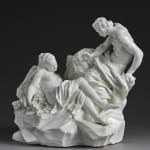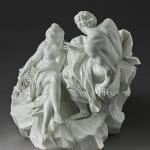



An Extremely Rare and Important Vincennes Figural Group of the Shepherd’s Hour (L'Heure du Berger), Circa 1748-1752
Further images
An Extremely Rare and Important Vincennes Figural Group of the Shepherd’s Hour (L'Heure du Berger), probably modelled after HYPERLINK "https://collections.louvre.fr/en/ark:/53355/cl020549484" Le repos de Diane by Jean Pelletier (1736-1780) after the painting by François Boucher (1703-1770). The nude figures, positioned next to a chiselled tree stump, are raised on a rocky crag. The female rests her dormant head, hair swept into a chignon with a ribbon band, her billowed robes draped over her crossed legs and swept behind her. Flowers are strewn beneath her dangled arm. The draped male, seated upright with muscular arched back, reaches his right hand out towards her, his face smiling with windswept locks.
The figures are thought to represent the mythological gods Zephyrus and Flora or Apollo and a sleeping nymph. The factory inventory of 1752 lists seventeen ‘groupes l’Heure du berger’. It is among the earliest sculptural works produced at Vincennes, which was founded in 1740. As Christopher Maxwell describes, ‘This model is one of the factory’s earliest and most accomplished…’.
Marks: Incised ‘P’ initial
Tamara Préaud provides further discussion of the group, where the inventory provides the first recorded sale of this model to M. de Crillon on 25 January, 1753 for 120 livres.
Known examples include:
An example in the Musée de Sèvres, Cité de la Céramique ( HYPERLINK "https://www.photo.rmn.fr/archive/15-524342-2C6NU0AOSI8SC.html" MNC25187)
An example in the Musée des Arts Décoratifs, Paris ( HYPERLINK "http://collections.lesartsdecoratifs.fr/l-heure-du-berger" 8859)
An example in the Philadelphia Museum of Art ( HYPERLINK "https://www.philamuseum.org/collection/object/167367" 1984-135-10)
One example lacking male figure is in the Fitzwilliam Museum, Cambridge ( HYPERLINK "https://collection.beta.fitz.ms/id/object/82556" EC.3-1944)
One mounted example identified as Apollo and Sleeping Nymph in the State Hermitage Museum, St. Petersburg (
collection/10.+porcelain%2c+faience%2c+ceramics/453239" ЗФ-21100)
Two mounted examples are in the Victoria and Albert Museum, London. One mounted with gilt bronze is illustrated as the front cover in Christopher Maxwell, French Porcelain of the Eighteenth Century (2009), cat. 65, p. 72.
The other example is decorated and marked with incised ‘P’ initial
An example formerly in the Tim Clarke Collection, sold at Sotheby’s 27 October, 2015.
An example mounted as a clock made for Jean-Baptiste de Machault d’Arnouville (1701-94), sold at Christie’s 14 October, 2020.
The scrolling ‘P’ initial indicates that this model may have been produced by the sculptor Gabriel Charles Patouillet or Patrouillet. Tamara Préaud discusses his activity at Vincennes between 1746-1750, where he is registered as ‘Sculpteur de l’Académie royale’. This mark is recorded on a similar example mentioned above in the V&A. It also appears on an early Vincennes model of a Lying Child in the Musée de Sèvres and Sleeping Children Kissing or Biting, illustrated in Joanna Gwilt, Vincennes and Early Sèvres Porcelain from the Belvedere Collection (2014), cat. 163, p. 226.
Literature
See discussion in Tamara Préaud and Antoine d'Albis, La Porcelaine de Vincennes (1991), p. 169, no. 167.
Join our mailing list
* denotes required fields
We will process the personal data you have supplied in accordance with our privacy policy (available on request). You can unsubscribe or change your preferences at any time by clicking the link in our emails.



